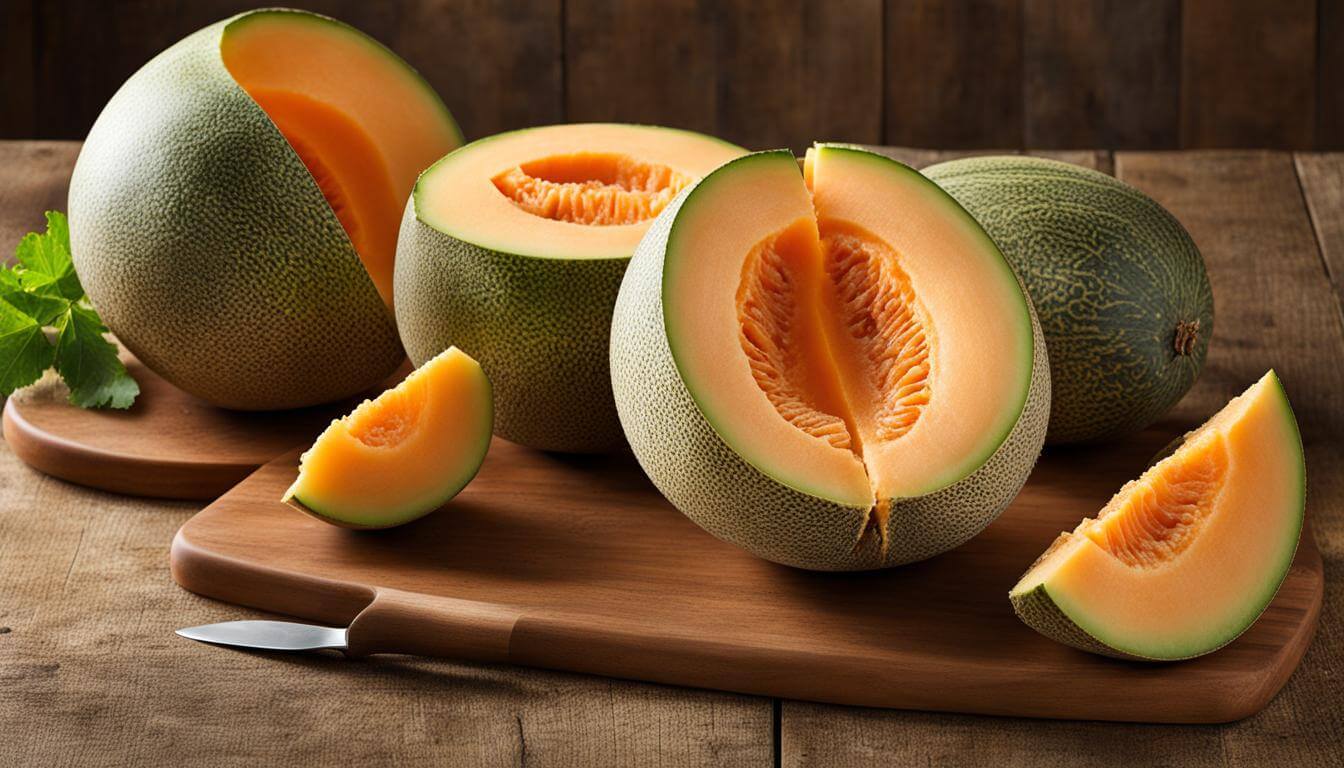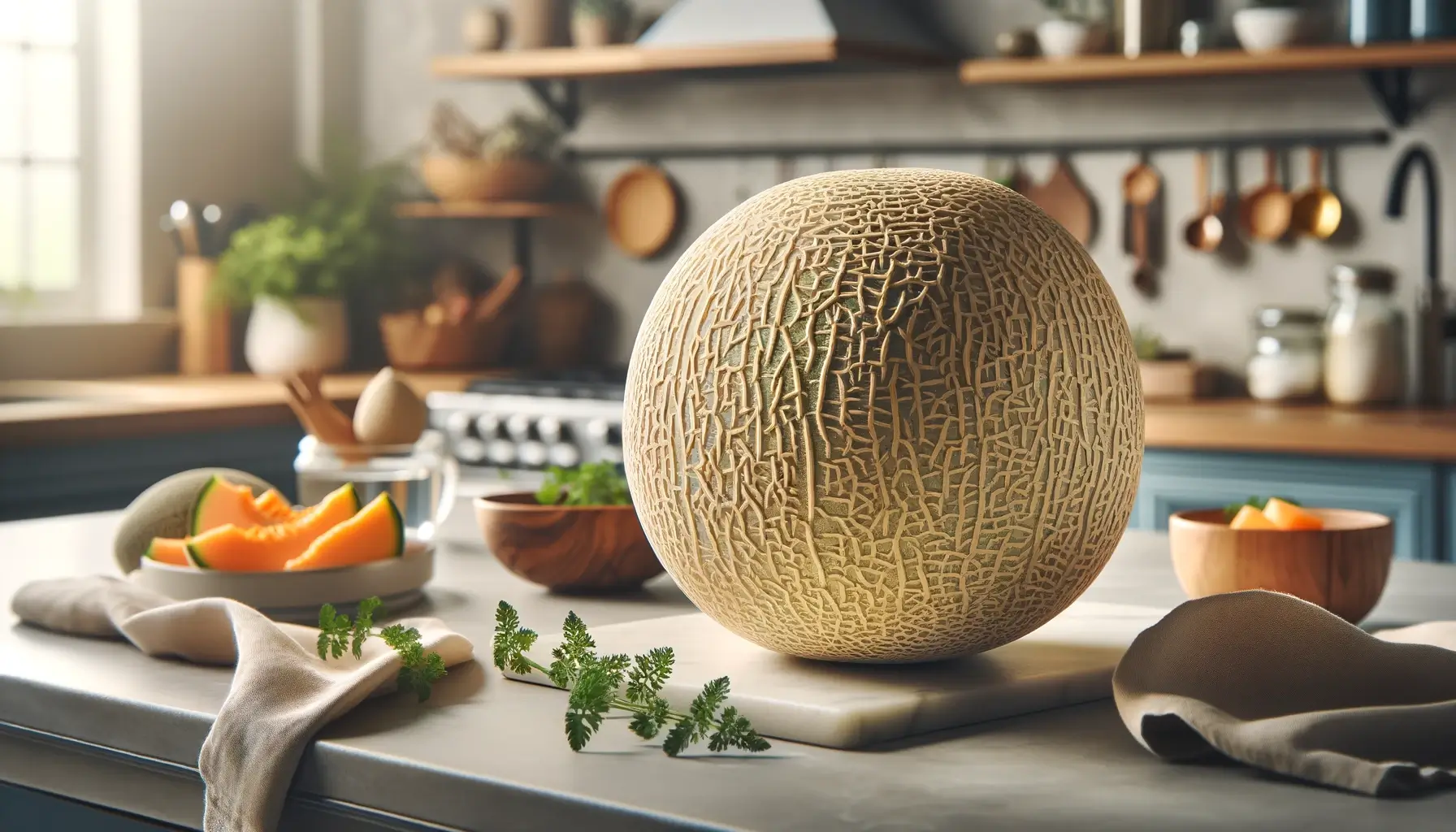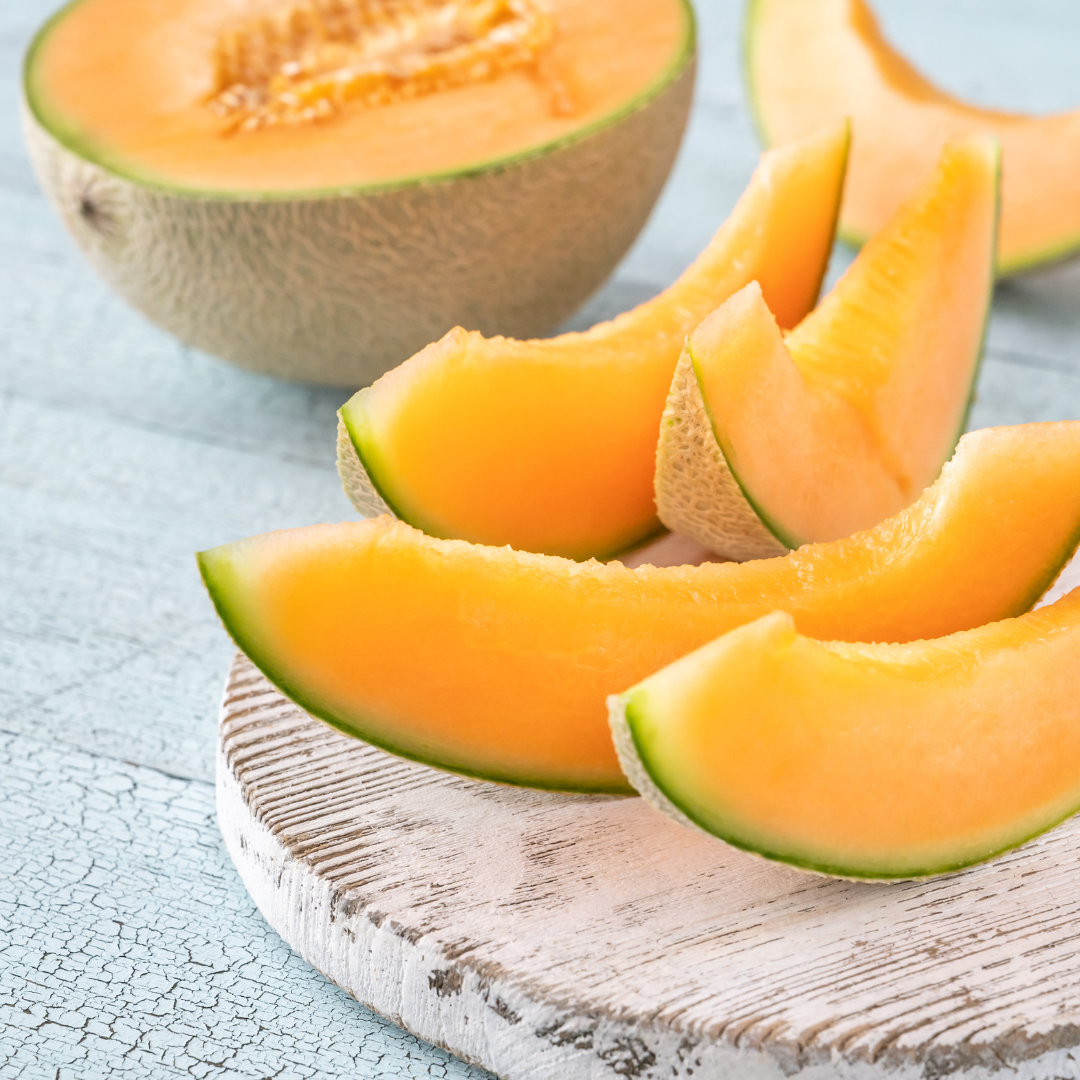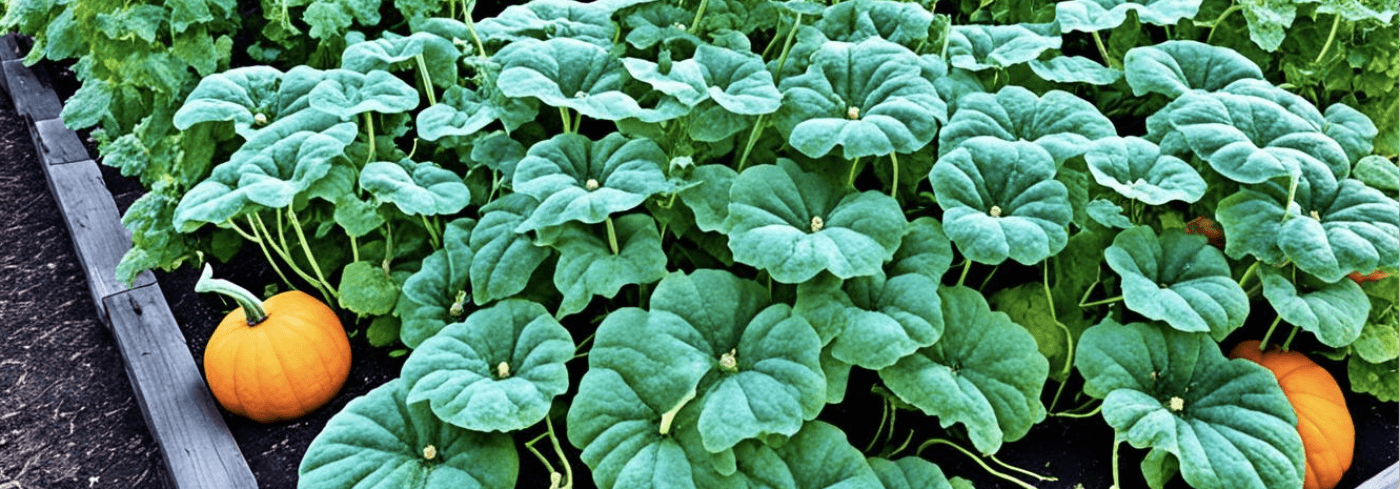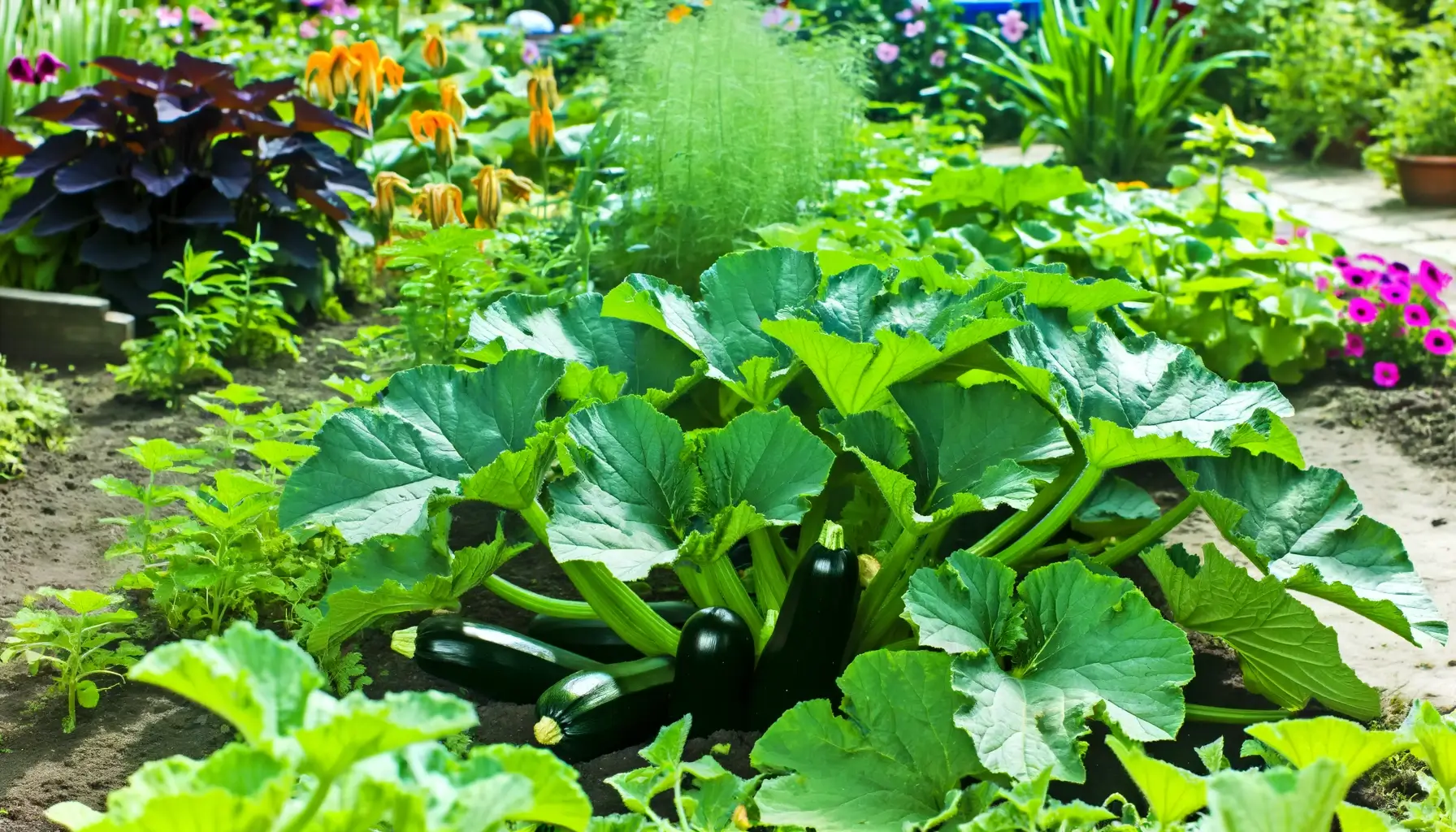“The love of gardening is a seed once sown that never dies,” resonated Gertrude Jekyll, an inspirational British horticulturist whose words echo the enduring passion of gardeners today. In harmony with Jekyll's sentiment, I journeyed to demystify the art of planting cantaloupe seeds, specifically focusing on the beloved variety, Hales Best Jumbo. My green-thumbed readers, join me as we learn how to grow Hales best jumbo cantaloupe from seed.
By selecting Gardeners Basics cantaloupe seeds, you are stepping onto a path paved with potential—potential for growth, learning, and savoring the sweet taste of success. The magic unfolds in the soil, where life begins, and with the proper guidance, your garden will burgeon with vibrant fruits of labor. Allow me to escort you through the lifecycle of these melons, from seed to sumptuousness.
Key Takeaways
- Choosing Gardeners Basics for quality cantaloupe seeds sets the stage for success.
- Understanding the specific needs of the Hales Best Jumbo variety is key to a bountiful harvest.
- Preparation begins with soil; creating a rich, nurturing environment is foundational for growth.
- Optimizing the germination process enhances the journey from seed to fruit.
- Every phase of cultivation offers lessons to enrich our own garden of experience.
- Persistence and care in gardening mirror the broader cycles of life and reward.
Hales Best Jumbo Cantaloupe Seeds
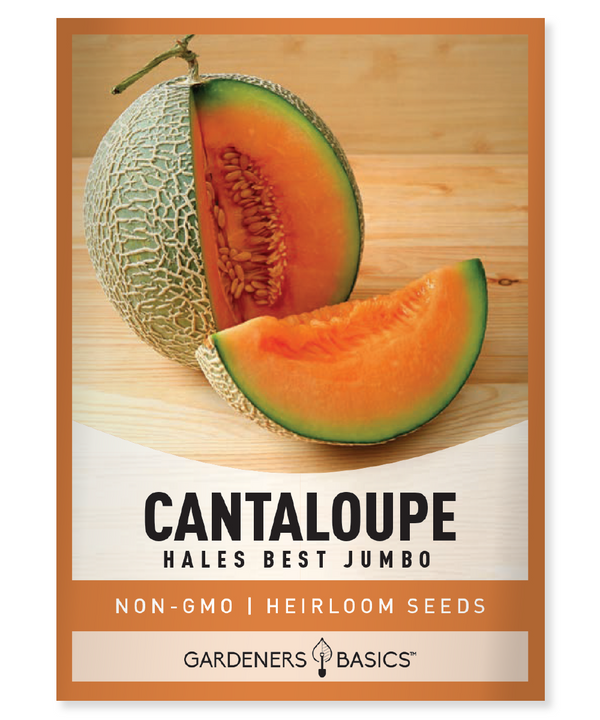
$2.49
Hales Best Jumbo Cantaloupe Seeds - Heirloom, Non-GMO, Non-Hybrid, Open-Pollinated Grow the sweetest and most aromatic cantaloupes with Hales Best Jumbo Cantaloupe Seeds, a classic heirloom variety cherished by gardeners for its exceptional flavor, vigorous growth, and high yields. These… read more
Hales Best Jumbo Cantaloupe Basics
- Days till maturity: Hales Best Jumbo Cantaloupe typically takes about 80 to 90 days to reach maturity after planting.
- Planting depth: Seeds should be planted about 1 inch (2.5 cm) deep.
- Plant spacing: Space plants about 36 to 42 inches (90 to 106 cm) apart in rows 4 to 6 feet (1.2 to 1.8 meters).
- Days to germination: Germination usually occurs in 4 to 10 days, depending on the soil temperature.
- Indoors or Direct Sown: These can be started indoors 2 to 4 weeks before the last frost date or directly sown into the garden after the danger of frost has passed.
- Full Sun or Partial Shade: Hales Best Jumbo Cantaloupe requires full sun to produce the best fruit.
- When to harvest: Harvest when the melons detach easily from the vine and when the netting is well-defined over a golden-brown background, typically 80 to 90 days after planting.
- How tall does the plant get? The plant is a vine; traditionally, it does not grow tall but spreads across the ground.
- How wide does the plant get? The vine can spread about 6 to 10 feet (1.8 to 3 meters) wide.
- Native: Cantaloupe is native to Africa and Iran but has been cultivated in many regions worldwide.
- Family: Hales Best Jumbo Cantaloupe is part of the Cucurbitaceae family, which includes gourds, pumpkins, and cucumbers.
Understanding Hales Best Jumbo Cantaloupe Varieties
As I delve into the distinctive attributes of the Hales Best Jumbo cantaloupe, it's easy to see why this variety stands out in the garden seed selection. Its heritage brings forth a robust tapestry of cantaloupe variety traits that entice novice and seasoned gardeners alike. This melon's growth habits and resilience set the bar for what to expect when cultivating melons tailored to warmer climates.
Characteristics of Hales Best Jumbo Cantaloupe
The Hales Best Jumbo is a renowned cantaloupe that has secured its place in gardens due to its distinctive features. It flaunts a netted rind paired with pronounced heavy ribbing, hallmark signs of its kind. Beneath that textured exterior lies a musky-sweet oasis, a flavor beloved by melon aficionados. In addition, the size of the Hales Best Jumbo is impressive and satisfying for those anticipating abundant harvests.
Why Choose Hales Best Jumbo for Your Garden?
Opting for your garden's Hales Best Jumbo variety goes beyond aesthetics and size. Its popularity has surged as gardeners witness its flavor and performance firsthand. Reliable and prolific, the vines of Hales Best Jumbo boast an uncanny ability to thrive even when faced with challenges that often plague other melons. This hardy nature, coupled with its taste and texture, makes it an indispensable jewel in the warm gardens of the United States.
| Traits | Description | Benefits |
|---|---|---|
| Size | Large, satisfying fruits | An ample harvest is ideal for sharing |
| Flavor | Musky-sweet with a succulent texture | Luscious taste that's highly sought-after |
| Resilience | Can withstand common growing challenges | Reliability throughout the growing season |
| Growth Habits | Prolific vines that adapt well to warmth | Well-suited for diverse garden environments |
The Hales Best Jumbo is more than a variety; it is a testament to the delightful intersection where garden selection meets quality and reliability. Let us continue to explore the nuances of this exceptional cantaloupe and the ways it can enrich our horticultural ventures.
Preparation of Soil for Cantaloupe Seeds
One of the most crucial steps in cultivating a successful cantaloupe crop begins long before the seeds even touch the earth. The foundation of a lush cantaloupe garden is inherently tied to the quality of your soil. In my gardening endeavors, I've observed that soil amendments play a pivotal role in yielding a nutrient-rich environment conducive to growth.
Instinctively, we understand that a plant's vigor is directly related to the soil's fertility. Therefore, creating a bed of well-drained, nutrient-rich soil tops the list of gardening tasks even before considering cantaloupe seed planting. To achieve this, I rigorously loosen the soil to foster the gentle penetration of tender roots and integrate organic compost or aged manure. This enriches the soil with a diverse array of essential nutrients.
Temperature, too, is an often understated yet significant character in the gardening narrative. Ensuring the soil temperature is adequately warm is as crucial as the nutrients provided; cantaloupes bask in the warmth. Thus, the advent of planting is deferred until the soil graciously welcomes seeds with its heat.
Every experienced gardener knows it is not just about placing the seed underground but understanding the ideal seed planting depth to usher in optimal growth. For Hales Best Jumbo cantaloupe seeds, this means a depth that allows for secure rooting and enough space for the sprout to break through to the surface.
- Blend in ample organic matter to increase water retention and nutrient availability.
- Monitor thermometers: soil warmth ensures the most hospitable conditions for seed germination.
- Measure your depths: plant seeds at a depth that provides the right balance of moisture and temperature and supports robust germination.
The initial preparatory measures often dictate the final bounty as we journey through the gardening season. These factors have perpetually steered me towards a bountiful yield of Hales Best Jumbo cantaloupes, and I trust they will do the same for my fellow garden enthusiasts. With our hands in the earth and our hopes held high, let's sow these seeds with the promise of sweet, lush cantaloupes in our future.
Seed Germination Techniques for Cantaloupe
Embarking upon the journey of germinating cantaloupe seeds, be it for the vaunted Hales Best Jumbo cantaloupe or any other variety, involves a careful blend of science and timing. In my experience with indoor seeding and outdoor planting, understanding the nuances of the germination process is paramount. Whether coaxing the seed in a regulated indoor setting or braving the elements for direct sowing, the germination temperature will be critical in jumpstarting your prized melons.
Indoor Seed Starting for Cantaloupe
When I commence with indoor seeding, I am not only granting these seeds a head start but also shielding them from the unpredictable whims of nature. The first step is to nestle each seed into a pot containing a seed starting mix crafted to nurture development. Here, in this sanctuary, temperature and moisture conspire in a controlled dance, optimizing the emergence of each tender shoot. Regions with fleeting summers benefit greatly from this method, as it elongates the growing season.
Direct Sowing Cantaloupe Seeds Outdoors
In contrast, outdoor planting lays bare the seeds to the elements, requiring a patient to wait for the soil to warm to the appropriate germination temperature. Only then will the Hales Best Jumbo seeds, like buried treasure, unlock their potential. Direct sowing connects the gardener to the earth in an intimate ritual, where each scoop of soil is a testament to the patience required to yield nature's bounty.
| Germination Technique | Advantages | Considerations |
|---|---|---|
| Indoor Seeding | Controlled environment, protection from weather, extended growing season | Requires space, monitoring, and potential transplanting |
| Outdoor Planting | Natural growth conditions, no transplant shock | Dependent on climatic conditions, germination temperature, and soil readiness |
Whether adopting the indoor or outdoor route, achieving success in the germination process demands reverence for timing and environment. My consistent application of these principles has never failed to assist me in cultivating healthy cantaloupe sprouts that are eager to grow and fruit. The secret lies in balancing warmth, care, and the innate rhythm of the seeds—elements I've found to be at the heart of every flourishing garden.
Optimal Growing Conditions for Hales Best Jumbo Cantaloupe
As I tend to my garden, ensuring the optimal growing conditions for the Hales Best Jumbo Cantaloupe is a fascinating exercise that requires unwavering attention to detail. These sun-loving melons demand consistent warmth and full sunlight exposure for vigorous growth. My experience tells me that soaking up the sunlight for at least six to eight hours daily is ideal for their development. Sunlight is not merely a light source; it's a crucial ingredient for photosynthesis, leading to rich, flavorful fruits.
When crafting a watering schedule, one must quench the plant's thirst judiciously, especially throughout the cantaloupe growth stages. The soil should always be moist but never wet to avoid the plague of root rot. Water is fundamental in transporting nutrients and the plant's well-being, so I carefully monitor the soil's moisture levels.
Temperature control is another pillar in the architecture of growing Hales Best Jumbo Cantaloupes. These plants flourish when basked in the day's warmth, with daytime temperatures ideally hovering around 70 to 90°F (21 to 32°C). To maintain a consistent environmental temperature, I sometimes play the roles of gardener and guardian, shielding my saplings from unpredictable cold snaps.
Gardeners must remain vigilant throughout the cantaloupes' lifecycle, providing unwavering support. The table below outlines the key conditions that I've observed to be critical in each of the distinct growth stages:
| Stage | Sunlight Exposure | Watering | Temperature |
|---|---|---|---|
| Seedling | Indirect light | Gentle moisture | 75-85°F (24-29°C) |
| Vining | Full sun | Consistent watering, avoid over-watering | 70-90°F (21-32°C) |
| Flowering | Full sun | Reduce frequency, increase quantity per watering | 70-90°F (21-32°C) |
| Fruit Setting | Full sun | Regular deep watering | 70-90°F (21-32°C) |
| Fruit Growth | Full sun | Decrease to prevent splitting | 70-90°F (21-32°C) |
| Harvesting | Full sun | Minimal to prevent over-ripening | n/a |
In summary, each Hales Best Jumbo Cantaloupe growth stage is a chapter in a horticultural odyssey where sunlight exposure, watering schedule, temperature control, and my dedication interlace to script a sweet, succulent finale. The meticulous calibration of these conditions is not just an exercise in precision; it's an embrace of the life-giving forces that yield a harvest worth the season's labor. Thus, the dance with nature continues, from the gentle introduction of sprouts to the grand crescendo of harvest time.
How To Grow Hales Best Jumbo Cantaloupe From Seed
Gardening is a labor of love, particularly when nurturing cantaloupes from a mere seed into a fruit bursting with flavor. However, setting off on the right foot is critical for securing a successful harvest. This begins with meticulous seed positioning, progresses through innovative ways to warm the soil, and culminates in steadfast seedling care. Let's grab our gardening tools and unearth the secrets to fostering the perfect environment for our Hales Best Jumbo Cantaloupe.
Planting Seeds an Inch Deep
Fostering robust cantaloupes hinges on the depth at which the seeds are sown. Too shallow, and they might fail to germinate; too deep, and they might not breach the surface. The sweet spot for seed positioning is about an inch deep. This ensures that seeds are ensconced in a nurturing embrace of soil, which protects and encourages optimal root development and growth.
Assorted Melon Seeds | 5 Variety Pack
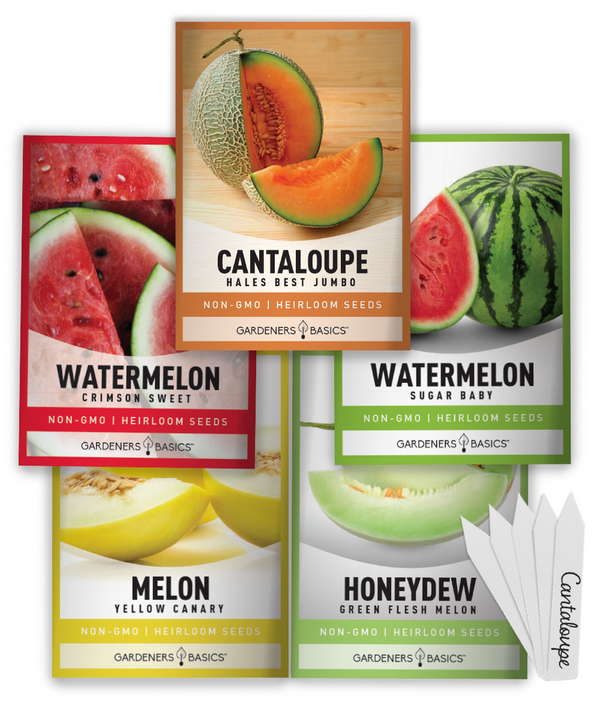
$9.95
Grow Fresh Summer Melons with Our 5-Pack Heirloom Melon Seeds Assortment Are you looking to add some variety to your home garden? Our melon fruit seeds 5 variety pack includes a mix of delicious and nutritious melon seeds that are… read more
Using Black Plastic to Warm the Soil
Employing black plastic mulch is a strategy I can't endorse enough. This robust tool serves a triple purpose: it warms the soil to create a cozier bed for the seeds, suppresses the growth of pesky weeds, and maintains necessary soil moisture. The black plastic mulch accelerates germination by keeping the soil snug and sets a robust stage for young plants.
Caring for Young Cantaloupe Plants
Caring for cantaloupe seedlings requires a keen eye and a gentle touch. After the successful germination under our black plastic mulch, it's imperative to thin the young plants to prevent crowding, which could otherwise stifle their growth. As the vines begin their journey, they need adequate support to encourage their natural climbing tendency. Throughout this stage, my vigilance in seedling care remains unwavering. It involves ensuring each plant's well-being through monitoring for pests, adequately spacing, and providing steady support for their burgeoning vines.
- Monitor for pests: An essential aspect of seedling care that can't be ignored.
- Thin seedlings diligently: Overcrowding can lead to undernourished plants and reduced yield.
- Supply ample support: As vines grow, they require structures to climb for optimal growth and fruit production.
The journey from seed to succulent cantaloupe is fascinating, with careful considerations and rewarding milestones. Following these guidelines gives our cantaloupe plants a robust foundation to thrive.
Pest and Disease Management for Healthy Cantaloupes
Ensuring cantaloupe health in your garden encompasses a range of preventative measures and actions targeted towards effective pest control and disease management. Let me walk you through some practical strategies that have proven successful in promoting the well-being of Hales Best Jumbo cantaloupes in various environments. By staying proactive, gardeners can protect these succulent fruits from common threats and enjoy a robust harvest season after season.
Common Pests Affecting Cantaloupes
Cantaloupe crops often prey on certain pesky insects that can impede growth and reduce yield. Cucumber beetles and aphids, in particular, have a notorious affinity for these melons. My approach to managing these invaders is consistent monitoring and applying natural solutions. Employing neem oil or insecticidal soap effectively curbs the pest population without resorting to harsh chemicals, thus ensuring a more organic approach to maintaining cantaloupe health.
In my personal gardening experience, the following table outlines what I consider the typical pests that hobbyists and professionals alike may encounter:
| Pest | Damage | Control Method |
|---|---|---|
| Cucumber Beetles | Eat plant leaves and spread diseases. | Introduce beneficial insects, and apply neem oil. |
| Aphids | Stunt growth by sucking sap and excrete honeydew, leading to sooty mold. | Use insecticidal soap and encourage natural predators. |
Disease Prevention and Control
Regarding disease management in cantaloupes, preventative measures outweigh the need for intervention after the fact. To this end, I've found that crop rotation and proper plant spacing are instrumental in hindering the onset of detrimental fungal diseases. Overhead watering, which often creates excess moisture on foliage, is a practice worth avoiding. Instead, water at the base of the plant to keep the leaves dry and less susceptible to fungal spores. If the need arises, organic fungicides serve as valuable tools to protect the health of the plants. Through these controlled practices, disease management becomes a manageable task that secures the vigor and productivity of the cantaloupe crop.
Below is a list of diseases I have recognized in my own gardens and how to handle them:
- Anthracnose manifests as sunken lesions on the fruit; using fungicides and removing affected plant parts can limit its spread.
- Powdery Mildew: Appears as a white powdery residue on leaves. Ensuring good air circulation and applying organic fungicides can control it.
- Downy Mildew: You might notice yellow spots on the leaves. Implementing good sanitation and using organic treatments can keep it at bay.
- Gummy Stem Blight: This is characterized by gummy exudates on stems. Crop rotation and proper sanitation are critical preventive practices.
As we conscientiously apply these pest and disease management tactics, we foster a growing environment where our cantaloupes can flourish. Remember, the key to thriving cantaloupe health is our preventative actions and vigilant care throughout the growing season. Through these continual efforts, I've celebrated many harvests rich with healthy Hales Best Jumbo cantaloupes.
Conclusion - How To Grow Hales Best Jumbo Cantaloupe From Seed
In our journey through the stages of cultivating the Hales Best Jumbo Cantaloupe, we've encountered a spectrum of growing challenges that have tested our resolve and enriched our understanding of this splendid fruit. Each challenge presented an opportunity for self-reflection and growth — hallmarks of a truly enjoyable gardening experience. My own gardener's reflections have underscored the importance of attentiveness to the microcosm of your garden, as local conditions demand a tailored approach to care and nurture.
As we anticipate the fruits of our dedicated labor, a successful cantaloupe harvest symbolizes the culmination of all these efforts — each sun-kissed melon a testament to the knowledge sown from packets of Gardeners Basics seeds. Each slice of cantaloupe-savored marks yields success and the invaluable lessons you've reaped.
To all who walk on this verdant path, these words may serve as guideposts, leading you towards lush, sprawling vines bearing the sweetest rewards. Keep the soil of curiosity fertile and your hands ever willing to delve into the earth, for it is here that we uncover the secrets to a bountiful garden and the roots of joy in the simple act of growing.
Watermelon Seed Assortment | 5 Delicious Varieties
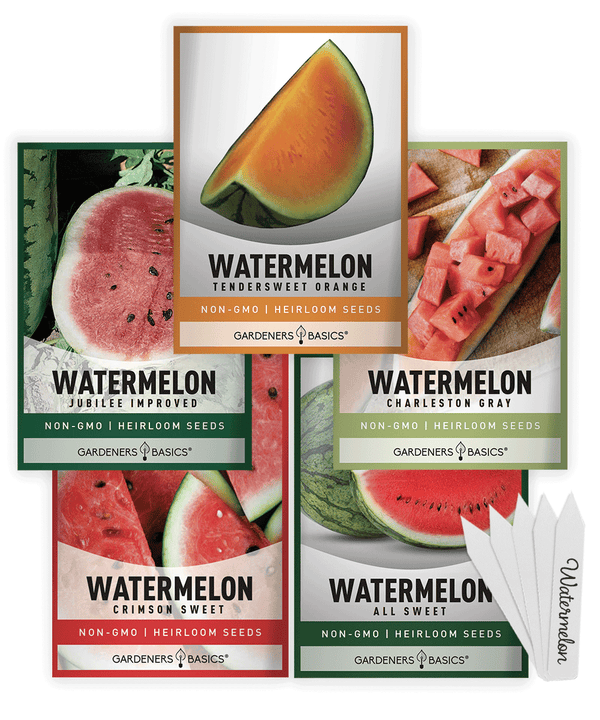
$9.95
Heirloom Watermelon Seed Assortment – Grow 5 Classic, Delicious, and Colorful Varieties Introducing our 5 Watermelon Seeds Variety Pack, the ultimate choice for gardeners and watermelon enthusiasts! This carefully curated pack includes five unique heirloom watermelon varieties, perfect for adding… read more
FAQ - Growing Hales Best Jumbo Cantaloupe
What makes Hales Best Jumbo Cantaloupe a popular variety for gardeners?
Hales Best Jumbo Cantaloupe is cherished for its large, sweet fruit with a netted rind and distinctive heavy ribbing. Its resilience and the prolific nature of its vines, which can withstand common growing challenges, make it a top choice for home gardens, particularly in warm climates.
How should I prepare the soil before planting cantaloupe seeds?
Preparing a bed of well-drained, nutrient-rich soil by loosening it and mixing in compost or aged manure is crucial. Ensuring the soil temperature is warm enough is vital, as cantaloupes thrive in heat.
Can I start cantaloupe seeds indoors, and if so, how?
You can start cantaloupe seeds indoors using individual pots and a seed starting mix. This allows for a controlled environment, especially in regions with shorter growing seasons. Optimize germination, maintain proper moisture, and monitor temperature.
Is it necessary to use black plastic when growing cantaloupes?
While not strictly necessary, black plastic mulch can be extremely beneficial for warming the soil, promoting faster germination, suppressing weeds, and conserving soil moisture. It's a strategic tool for providing optimal growing conditions for cantaloupes.
How do I manage pests and diseases in my cantaloupe garden?
Regular inspection for pests like cucumber beetles and aphids is essential, and these can be managed with natural treatments such as neem oil or insecticidal soap. To prevent diseases, practice crop rotation, ensure proper plant spacing, and use drip irrigation to minimize leaf wetness. Organic fungicides can also help maintain the health of your cantaloupes.
When is the best time to direct sow cantaloupe seeds outdoors?
The best time for direct sowing cantaloupe seeds outdoors is when the soil has sufficiently warmed to about 70°F or higher, typically after the last frost date in your region. This helps ensure a more successful germination process.
How deep should I plant cantaloupe seeds?
Cantaloupe seeds should be planted about an inch deep. This depth helps ensure proper root establishment and growth, and it's an important step in the seed-sowing process.
What are the ideal growing conditions for Hales Best Jumbo Cantaloupe?
Hales Best Jumbo Cantaloupe thrives in consistent warmth, full sunlight exposure, and requires a steady supply of water, especially during fruit setting and growth stages. Overwatering should be avoided, and it's important to maintain an optimal temperature range throughout the growing season.
How do I care for young cantaloupe plants?
Young cantaloupe plants need diligent care, including monitoring pests, thinning seedlings to avoid overcrowding, and providing support as vines grow. Regular water and balanced fertilizer are also important to their health and fruit production.
What are the benefits of choosing Gardeners Basics cantaloupe seeds?
Opting for Gardeners Basics cantaloupe seeds ensures that you are starting your gardening journey with high-quality seeds with a better chance of germinating and growing into healthy, fruitful plants.
Seed Safe Survival Seed Kit - 35 Variety Pack
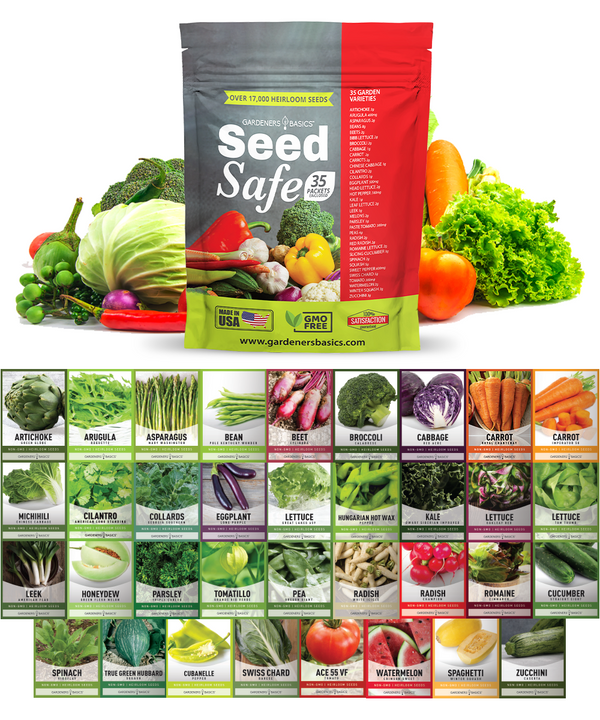
$29.95
$49.95
Seed Safe Survival Seed Kit: The Ultimate Heirloom Collection for Self-Sufficient Gardening Introducing the Seed Safe - 35 Varieties of Heirloom Vegetable, Herb, and Fruit Seeds, the ultimate solution for gardeners who want to secure a bountiful future harvest. This… read more



